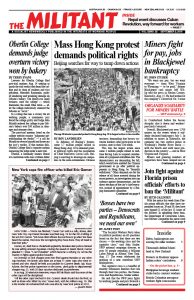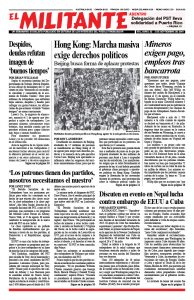In defiance of Beijing’s threats, some 1.7 million people rallied in Hong Kong Aug. 18 to demand greater political rights and the resignation of Chief Executive Carrie Lam. Beijing is exerting its leverage on companies in the semi-autonomous Chinese territory, demanding that bosses victimize workers who participate in the actions, now in their 11th week.
This was the largest action since some 2 million people rallied in mid-June forcing Lam to suspend consideration of a proposed extradition law. The demonstrators are demanding the bill, which would have enabled the Chinese government to go after political opponents in Hong Kong, be “formally withdrawn.” Other demands are for the release of all those arrested during the recent protests, an investigation into cop violence against demonstrators, and for direct elections of the city’s chief executive, instead of appointment by a Beijing-dominated committee.
“Should the situation in Hong Kong deteriorate further,” warned Liu Xiaomong, Beijing’s ambassador to the U.K., Aug. 15, “the central government will not sit on its hands and watch.”
Thousands of members of China’s People’s Armed Police with hundreds of trucks and armored vehicles began practicing drills earlier this month in Shenzhen, just across the land border.
A Hong Kong rally of almost 200,000 June 4 marked the 30th anniversary of the Chinese government’s bloody suppression of protesters demanding political rights in Tiananmen Square in Beijing. Although the Chinese government seeks to erase the memory of the massacre it carried out, Hong Kong is the one place in China where that event is still publicly commemorated.
The scale of the latest mobilization makes it harder, for now, for Beijing to launch a military intervention. It has used assaults by smaller groups of protesters on Hong Kong’s legislative building, police stations and symbols of its presence to claim that the broader movement for political rights is led by “terrorists.”
The Hong Kong Professional Teachers’ Union said 22,000 of its 100,000 members attended a protest Aug. 17 to back the demands of the Civil Human Rights Front. Wilson Ng, a teacher who joined the rally as well as the large protest the next day, told the Militant by phone that the teachers’ action was to show support for the students who had led many of the protests. But Ng added that many people want to return to “using peaceful means to achieve our democratic demands.”
In the citywide strike Aug. 5, over 1,000 workers at Hong Kong-based Cathay Pacific Airways took part, forcing the cancellation of 150 of its flights. Hundreds more were cancelled when the airport was paralyzed by an occupation of thousands Aug. 12-13.
Beijing uses economic clout
The Chinese government has begun using its economic weight to pull the territory’s companies into line demanding they victimize workers joining the popular protests.
Chinese civil aviation authorities laid down the law to Merlin Swire, the billionaire owner of Cathay, in Beijing Aug. 12. He responded by firing four employees, including two pilots who had joined protests. On Aug. 16 China’s state-run media announced the airline’s two top officials were being replaced. China Central Television called it punishment for management’s “sins.”
Cathay and its subsidiary airlines are heavily reliant on Chinese flights and customers for over half its commerce.
Carol Ng, a flight attendant and chair of the Hong Kong Confederation of Trade Unions, told the Wall Street Journal that Beijing’s message was “go back to your job, keep your mouth shut.”
But, she added, “I don’t think Hong Kong people will agree to keep their mouths shut.”
Beijing fears the impact that the fight for political rights will have on working people elsewhere across China who face attacks on jobs, living standards and working conditions.
Hong Kong, a former British colony, was handed over to China in 1997 as a semi-autonomous zone under a “one country, two systems” arrangement for 50 years. That year the economy of Hong Kong was one-fifth the size of mainland China. Now, since China’s rapid capitalist expansion, the country’s economic weight is 30 times larger than that of Hong Kong. In 1997 nearly half of China’s trade was through Hong Kong, but today it is less than 12%.
Nonetheless, Hong Kong continues to be an important international financial center with its own currency, pegged to the U.S. dollar. It remains the main conduit for foreign investment into China. It is also the main channel for wealthy Chinese to send their money out of the country.


